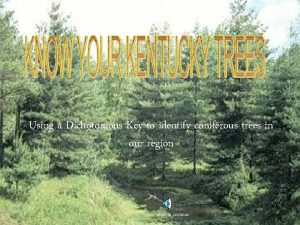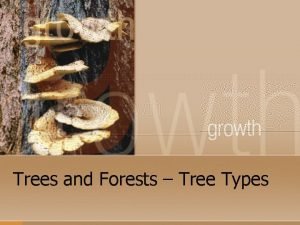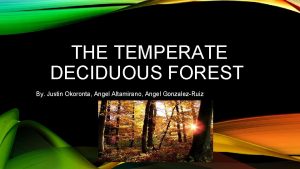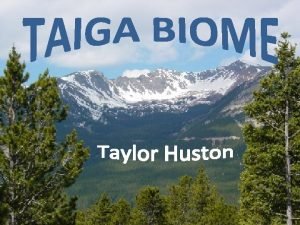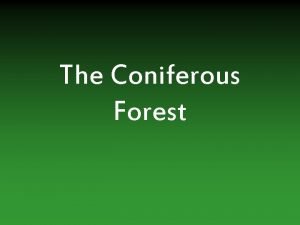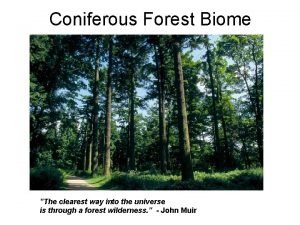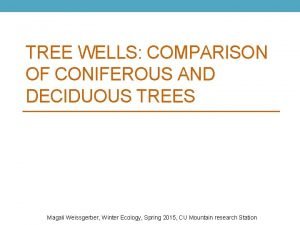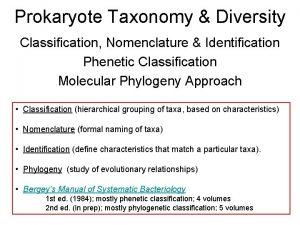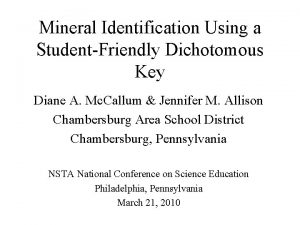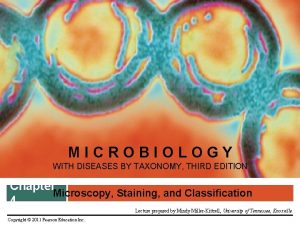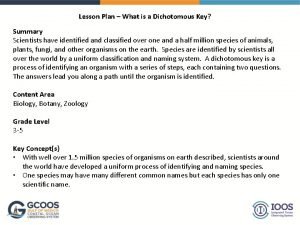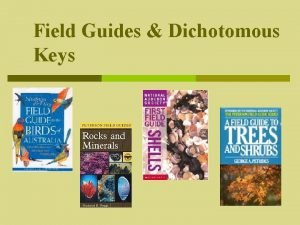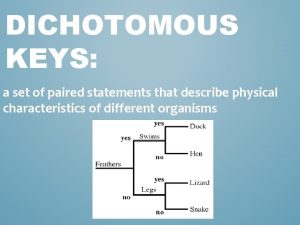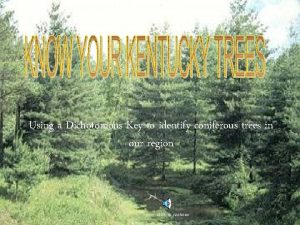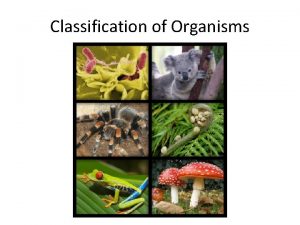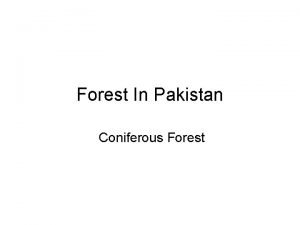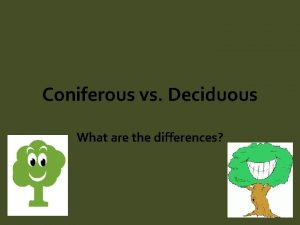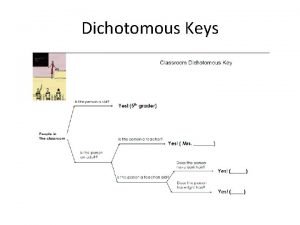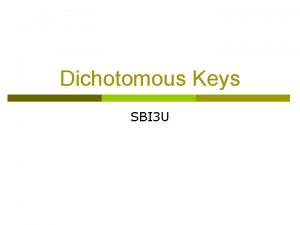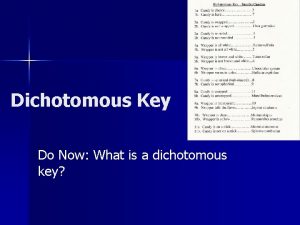Using a Dichotomous Key to identify coniferous trees




















- Slides: 20

Using a Dichotomous Key to identify coniferous trees in our region click to continue

How to Use this Dichotomous Key to Identify Evergreen Trees • • Your teacher will give you a small tree sample to observe. As you work through this Powerpoint you will need to observe and make specific decisions about the needles and cones or seeds of your sample. The Powerpoint will ask you to make choices about the sample. Having a small ruler may be helpful unless you are a good judge of size or length. If you think you have reached a slide in error, right click and choose Previous slide to return to where you started.

Look closely at your leaf sample and decide between the two choices given below 1 a. If your leaves are needle-like, Click here 1 b. If your leaves are scale-like, Click here

2 a. Are these evergreen needles arranged in clusters of 2 -5? These are pine trees. Choose one from below. For clusters of 2 For clusters of 3 For clusters of 5 or 2 b. Are these evergreen needles arranged singly around the twig?

SCALE-LIKE NEEDLES v v Are the leaves yellow-green, overlapping scales that circle the twigs, and are arranged in fan-like sprays? It is a northern white cedar or Are the leaves dark green, blue-green, or purple-green, and scales circle the twig but are not arranged in flattened sprays? It is an eastern red cedar.

Northern White Cedar Thuja occidentalis This tree is easy to identify. Look for small, flat branches with close-knit, scale -like leaves. It also grows as a compact tree with lots of branches like a thicket (thick bush). The leaves of this tree give off a pleasant aromatic scent when you crush them between your fingers. Many people like to have ornamental varieties of the "arbor vitae" (French word meaning tree of life) in their yard. A row of these trees acts as a natural fence because the branches grow so thick. Deer love to browse on this evergreen in the winter when food is scarce. Porcupines eat the thin cedar stems as a tasty snack and red squirrels nibble on the buds. Pileated woodpeckers will excavate large, oval holes in the sides of the white cedar in search of carpenter ants. The cone, or fruit, is small (1/3 -1/2 inches long) and oval. It is yellowish-brown with 6 -12 scales and grows alone or in clusters on the end of the branch. The seeds are about 1/8 of an inch long and have two narrow wings almost circling the seed. The bark is thin with a gray or reddish-brown color that grows in long, vertical, narrow shreddy strips. People use the light, soft and brittle wood for making fence posts, building poles, rot-resistant lumber, and shingles for buildings.

Eastern Red Cedar Juniperus virginiana This evergreen has a rounded shape with two different kinds of leaves. Most likely you’ll find dark green, miniature leaves that look like scales. They are in groups of four finger-like leaves. The other leaf type is found on young trees or new shoots. They have sharply pointed ends with white coloring on the underside. The bark on this tree is just like the northern white cedar, with reddish-brown strips that look shredded vertically. The red cedar grows as high as 30 feet tall. It likes to grow in dry, gravelly soil and rocky ledges in the southern half of the state. You’ll also see the red cedar growing in abandoned fields. The red cedar’s fruit is easy to spot. It has a dark blue berry-like cone, about 1/4 of an inch in diameter. There are four seeds inside the sweet flesh. These fruits make a winter’s meal for some birds. Song sparrows sometimes nest on the ground under the cedar. The wood is fragrant and durable. People use it for woodwork in their homes, hope chests, closets, for lead pencils, posts and poles.

Clusters of 2 Are the needles mostly 3/4"-1 1/2" long, yellow-green, and widely spread in bunches? It is a jack pine. OR Are the needles 1 1/2"-4" long, bluegreen to yellow-green, and twisted? It is a scotch pine.

Jack Pine (Pinus banksiana) This tree can be found on sandy soils. The jack pine is unique because its resinous cones open and release seeds during a fire or from an intense, hot sun. They are the first tree to grow in the burned over area. They grow 50 -70 feet tall. The trunks stay small at under 2 feet in diameter. The tree shape is conical (like a cone). It keeps dead branches on the trunk all the way to the ground. Look for dark brown bark with small scales divided by deep furrows (indented lines). Jack pine needles are dark to yellow-green, sharply pointed and measure 1 inch long. They grow in bundles of two needles that are slightly twisted. Their cones are uniquely shaped with a wide base curving to a rounded narrow end. They are about 1 1/2 inches long, resinous, and brown when they are ripe. Sometimes they stay on the branches and don’t open for many years. The seeds inside are small-winged triangular seeds that can be carried far by strong winds. Their wood is light and soft. They are used mostly for pulpwood for papermaking, but they are also used for box material and lumber. The Kirtland’s warbler depends on young jack pines to provide nesting habitat. Animals that urrow live in the barren jack pine understory; mammals, snakes, salamanders and insects. . Black bears like to feed in small openings in a pine forest or rest their weary bones in the cool shade. In the winter, snowshoe hares, deer, spruce grouse, and porcupines come in search of plants to browse on.

Scotch Pine Pinus sylvestris A beautiful evergreen which is hardy and adaptable to nearly all climates. Can be used as either a windbreak or a single specimen. Grows to 60‘ in height and 40' spread. This tree’s pair of spiral needles are 2 to 4 inches long. The Scotch pine does well in full sun and will tolerate moderate drought conditions. It grows in acidic, drought tolerant, loamy, moist, sandy, well drained, wide range, and clay soils. Scotch Pine trees are widely used for Christmas trees because of their excellent form and their ability to hold their needles for a long period of time. There are many color variations within the species and some trees are sprayed with green color to make them more attractive as some naturally have brown needles during the winter months. It is also a good tree for reclamation sites because of its re-seeding capabilities. The Scotch Pine provides nesting sites and winter cover for many kinds of mammals and birds. It was widely planted on old farm fields at the turn of the century. Early farmers were familiar with this species from its growth throughout Europe and knew it could tolerate poor, dry soil. Eventually they found that the trees did not mature into the fine timber stands they envisioned, but often stagnated or had twisted trunks. It was the beginning of the realization that seed sources vary widely and must be matched to the planting site. Today, seed sources are selected with care and varieties of Scotch Pine are favored to provide the species' best qualities, especially when planting for the Christmas tree market.

Clusters of 3 Are the needles 3"-5" long, somewhat twisted, often sprouting in tufts from the trunk? It is a pitch pine. OR Are the needles 6"-9" long? It is a loblolly pine.

PITCH PINE Pinus rigida Pitch Pine is one such conifer. Pitch Pine is found in the northern half of the Eastern Deciduous Forest and is the dominant tree species is areas of sandy soils. Pitch Pines can grow to 50 or 60 feet in height, but under the worst conditions in very arid, sandy soils they can be stunted. All pine trees have needles in bundles. Pitch Pine has three needle per bundle, although other pine species have differing numbers of needles in a bundle. The fruit of pine trees is distinctive. The pine cone of Pitch Pine is from 3 to 5 inches long, brown when mature and composed of a number of cone scales each tipped with a short, hooked spine. Pitch Pine is highly adapted to fire. The cones may stay closed on the trees for up to 10 years, opening only when fire passes through the stand. The opening cones seed the newly opened land for the next generation of Pitch Pine, unlike most conifers, can sprout from the base of the tree if the tree has been destroyed by the fire. An ecosystem whose dominance in a region is promoted by fire is called a Fire Disclimax.

Loblolly Pine Pinus taeda Loblolly Pine is characterized by needles in bundles of 3 from 6 to 9 inches long. The cones are elongate and cylindrical (6 – 9 in. ) and the mature tree is tall with spreading branches. Mature individuals 80 to 100 feet tall with a straight trunk and widely spread branches. The trunk is about 2 feet wide at breast height. Cones scales are thin, rounded at the apex and with a short apical spine. Needles are 6 to 9 inches long, slender, but stiff. The color may be yellow-green or pale green and the needles may be slightly twisted. The native range of Loblolly Pine extends through 14 States from southern New Jersey south to central Florida and west to eastern Texas. Loblolly Pine does not grow naturally in the Mississippi River flood plain. Loblolly Pine is an adaptable species that has been successfully planted along the periphery of its natural range and has been introduced on other continents with varying degrees of success.

Clusters of 5 Are the needles clustered in groups of 5 and the cones long with thin scales? It is an eastern white pine.

Eastern White Pine (Pinus strobus) This popular tree grows statewide in sandy, well-drained soils and along rock ridges. The white pine has a straight stem and a nice pyramid shape with soft gray-green needles, making it one of the most majestic trees in the state. It can grow to be 100 feet tall. The bark is thin greenish-gray on young bark, but gray, thick and deeply cut on older trees. Look for the distinctive bluish-green needles that are 3 -5 inches long. They grow in bundles of five. You can remember that the white pine has five needles per bundle by counting the number of letters in the word white (5). White = five letters, white pine = five needles. The cones are long (4 -6 inches) with thin and far-spread scales that each contain two small winged seeds. Cones mature after two years, in August or September. The wood from the white pine is light and soft, used for making matches and lumber. People also make cabinets, windows, interior woodwork and wooden craft items. White pine is very susceptible to air pollution damage and can be an indicator of poor air quality.

Single needles around the twig Are the needles fairly easy to roll between your fingers? These are spruce trees. OR Are the needles difficult to roll between your fingers? This is a bald cypress.

Spruce Picea Most spruce needles are four-sided, stiff, and less than one inch long, 2. 5 centimeters to be exact. Woody, peglike projections help join the needles to the twigs. Spruce trees grow tall and most are shaped like pyramids. Some grow as tall as one hundred and fifty feet, specifically the white spruce. The spruce tree is an evergreen color but specific types of spruces, the black spruce for example, are named for the color of their bark and foliage. The needle-like leaves attached to the common spruce trees are used to hold in moisture. The blue spruce is widely planted in yards because of its beautiful silver-blue foliage. Some spruce trees grow beyond the Arctic Circle, whereas others can grow as far south as the Pyrenees Mountains. Approximately forty different types of spruce trees are native to the Northern Hemisphere. In North America, spruce trees grow as far south as North Carolina and Arizona. The Sitka spruce grows on the Pacific Coast from northern California to Alaska.

Bald Cypress Taxodium distichum The Baldcypress tree is the classic tree of southern swamps. There, in its native habitat, it displays a peculiar habit of raising conical "knees" from its roots. The function of these growths is something of a mystery, although some believe it is a way to help the roots get oxygen. This tree dwells in swamps because it out-competes most other trees on such sites. To the surprise of some people, when the Baldcypress is planted on the right soil in yards or along streets, it does quite well and is a beautiful specimen tree. It has been grown successfully in cities as far north as Milwaukee and on dry Texas hills. A stately deciduous conifer adaptable to wet or dry conditions. Best known in wet areas, does well in city conditions as far north as Milwaukee. As a benefit to wildlife the Baldcypress form characteristic groves in swampy areas that support complex and variable ecosystems, and are used by many wildlife species. Baldcypress trees are native from Maryland along the eastern coast to Texas and as far west as the Mississippi valley. The first scientific reference to the species was made in 1640. This tree has inspired much poetry and prose over the centuries due to its melancholy and mysterious appearance.

Related Internet Sites Title and Internet Address Description Grade Level Comparing Leaves http: //ericir. syr. edu/cgibin/printlessons. cgi/Virtual/ Lessons/Science/Botany Students will compare trees by studying leaves, in order to tell them apart and will be able to determine differences in trees by their leaves, seeds, and flowers. Kdg. - 6 Deciduous and Coniferous Trees http: //ericir. syr. edu/cgibin/printlessons. cgi/Virtual/ Lessons/Science/Botany There are distinguishing characteristics of deciduous and coniferous trees. Students will learn through a hands-on approach about these characteristics. 3 -5 What Tree is That ? http: //www. arborday. org/tree s/tree. ID. html Dichotomous key activity for simple identification of trees as they are listed regionally in our country. Samples of tree leaves and fruit / cones is helpful. 4 -8 Provides information on many of the common trees native to Kentucky 3 -8 Kentucky Trees http: //www. uky. edu/Ag/Horti culture/kytreewebsite/welcom e. htm

Related Internet Sites cont. Title and Internet Address Description Grade Level What Tree Is This? http: //www. oplin. lib. oh. us/product s/tree/ You see an unknown tree. Or perhaps have found part of a tree, and you want to know from what kind of tree it came. Often, you can identify an unknown tree by just one part, such as a leaf or a fruit. 3 -6 Arbor Day Foundation: Tree Guide http: //www. arborday. org/trees/tre eguide/browsetrees. cfm detailed information on dozens of commonly planted landscape trees that grow throughout the United States. Here you will find information on height and spread, soil and sun requirements, leaves and fruit, history, wildlife habitat, and more 6 - 10 Environmental Education for Kids http: //www. dnr. state. wi. us/org/ca er/ce/eek/veg/trees/ This section of the webpage Environmental Education for Kids is actually from the state of Wisconsin. Many of these trees are also found in our state. This page gives excellent descriptions and advantages to choosing these trees. 4 -8 Native Conifers of North America http: //www. nearctica. com/trees/c onifer/index. htm Online dichotomous key and specific descriptions of trees including identifying characteristics, range and habitat. 4 -8
 Dichotomous key coniferous tree identification
Dichotomous key coniferous tree identification Dichotomous key pine trees
Dichotomous key pine trees Venn diagram of coniferous and deciduous trees
Venn diagram of coniferous and deciduous trees Venn diagram of coniferous and deciduous trees
Venn diagram of coniferous and deciduous trees Description of taiga biome
Description of taiga biome Define coniferous forest
Define coniferous forest Northwestern coniferous forest biome
Northwestern coniferous forest biome Tree well definition
Tree well definition Identify the tests in the dichotomous key
Identify the tests in the dichotomous key Mr men dichotomous key
Mr men dichotomous key Dichotomous key rules
Dichotomous key rules Dichotomous key for 6 kingdoms
Dichotomous key for 6 kingdoms Dinosaur dichotomous key
Dinosaur dichotomous key Mineral identification dichotomous key
Mineral identification dichotomous key Dichotomous key for microbiology
Dichotomous key for microbiology Dichotomous key activity middle school
Dichotomous key activity middle school Dichotomous key
Dichotomous key Shark dichotomous key answers
Shark dichotomous key answers Creature dichotomous key
Creature dichotomous key Penguin dichotomous key
Penguin dichotomous key Wep key cracker
Wep key cracker
